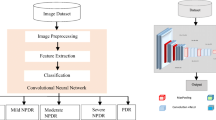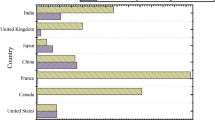Abstract
Diabetic Retinopathy (DR) has become a major cause of blindness in recent years. Diabetic patients should be screened on a regular basis for early detection, which can help them avoid blindness. Furthermore, the number of diabetic patients undergoing these screening procedures is rapidly increasing, resulting in increased workload for ophthalmologists. An efficient screening system that assists ophthalmologists in DR diagnosis saves ophthalmologists a lot of time and effort. To address this issue, an automatic DR detection screening system is required to improve diagnosis speed and detection accuracy. Appropriate treatment can be provided to patients to prevent vision loss if the severity levels of DR are accurately diagnosed in the early stages. A growing number of screening systems for DR diagnosis have been developed in recent years using various deep learning models, and the majority of the published work did not include any optimization algorithm in the neural network for severity classification. The use of an optimization algorithm with the necessary hyper parameter tuning will improve the model’s performance. Considering this as motivation, we proposed a five-phase DFNN-LOA model. The DFNN-LOA algorithm presented here has five phases: (i) pre-processing, (ii) optic disc detection, (iii) segmentation, (iv) feature extraction, and (v) severity classification. The proposed model’s experimental analysis is carried out on the MESSIDOR dataset. The experimental results show that the proposed DFNN-LOA model has superior characteristics, with maximum accuracy, sensitivity, specificity, F1-score, PPV, and NPV of 97.6%, 98.4%, 90.7%, 96.5%, 94.6%, and 97.1%, respectively.

















Similar content being viewed by others
References
Amin J, Sharif M, Rehman A et al (2018) Diabetic retinopathy detection and classification using hybrid feature set. Microsc Res Tech. https://doi.org/10.1002/jemt.23063
Sisodia DS, Nair S, Khobragade P (2017) Diabetic retinal fundus images: preprocessing and feature extraction for early detection of Diabetic Retinopathy. Biomed Pharmacol J. https://doi.org/10.13005/bpj/1148
Akram MU, Khalid S, Khan SA (2013) Identification and classification of microaneurysms for early detection of diabetic retinopathy. Pattern Recogn 46:107–116. https://doi.org/10.1016/j.patcog.2012.07.002
Usman Akram M, Khalid S, Tariq A et al (2014) Detection and classification of retinal lesions for grading of diabetic retinopathy. Comput Biol Med. https://doi.org/10.1016/j.compbiomed.2013.11.014
Vasireddi HK, Suganya Devi K (2021) An ideal big data architectural analysis for medical image data classification or clustering using the map-reduce frame work. In: Lecture Notes in Electrical Engineering. pp 1481–1494. https://doi.org/10.1007/978-981-15-7961-5_134
Issac A, Dutta MK, Travieso CM (2020) Automatic computer vision-based detection and quantitative analysis of indicative parameters for grading of diabetic retinopathy. Neural Comput & Applic 32:15687–15697. https://doi.org/10.1007/s00521-018-3443-z
Zhou Y, Wang B, Huang L, et al. (2020) A benchmark for studying diabetic retinopathy: segmentation, grading, and transferability. arXiv 1–11. https://doi.org/10.1109/TMI.2020.3037771
Goluguri NVRR, Suganya Devi K, Vadaparthi N (2020) Image classifiers and image deep learning classifiers evolved in detection of Oryza sativa diseases: survey. Artif Intell Rev. https://doi.org/10.1007/s10462-020-09849-y
Qureshi I, Ma J, Abbas Q (2019) Recent development on detection methods for the diagnosis of diabetic retinopathy. Symmetry (Basel). https://doi.org/10.3390/sym11060749
Wan S, Liang Y, Zhang Y (2018) Deep convolutional neural networks for diabetic retinopathy detection by image classification. Comput Electr Eng 72:274–282. https://doi.org/10.1016/j.compeleceng.2018.07.042
Verma K, Deep P, Ramakrishnan AG (2011) Detection and classification of diabetic retinopathy using retinal images. In: Proceedings - 2011 Annual IEEE India Conference: Engineering Sustainable Solutions, INDICON-2011
Liao M, Zhao YQ, Wang XH, Dai PS (2014) Retinal vessel enhancement based on multi-scale top-hat transformation and histogram fitting stretching. Opt Laser Technol 58:56–62. https://doi.org/10.1016/j.optlastec.2013.10.018
Bharkad S (2017) Automatic segmentation of optic disk in retinal images. Biomed Signal Process Control 31:483–498. https://doi.org/10.1016/j.bspc.2016.09.009
Wu J, Zhang S, Xiao Z et al (2019) Hemorrhage detection in fundus image based on 2D Gaussian fitting and human visual characteristics. Opt Laser Technol 110:69–77. https://doi.org/10.1016/j.optlastec.2018.07.049
Lam C, Yi D, Guo M, Lindsey T (2018) Automated detection of diabetic retinopathy using deep learning. AMIA Jt Summits Transl Sci proceedings AMIA Jt Summits Transl Sci. 147-155. https://pubmed.ncbi.nlm.nih.gov/29888061.Accessed 15 Dec 2020
Amin J, Sharif M, Yasmin M et al (2017) A method for the detection and classification of diabetic retinopathy using structural predictors of bright lesions. J Comput Sci 19:153–164. https://doi.org/10.1016/j.jocs.2017.01.002
Ghosh R, Ghosh K, Maitra S (2017) Automatic detection and classification of diabetic retinopathy stages using CNN. In: 2017 4th International Conference on Signal Processing and Integrated Networks, SPIN 2017. https://doi.org/10.1109/SPIN.2017.8050011
Gardner GG, Keating D, Williamson TH, Elliott AT (1996) Automatic detection of diabetic retinopathy using an artificial neural network : a screening tool. 940–944
Li Y, Yeh N, Chen S, Chung Y (2019) Computer-assisted diagnosis for diabetic retinopathy based on fundus images using deep convolutional neural network. 2019. https://doi.org/10.1155/2019/6142839
Izzati N, Kader A, Kalsom U, Naim S (2019) Diabetic retinopathy classification using support vector machine with hyperparameter optimization. 11. http://home.ijasca.com/data/documents/5_p76-93_Diabetic%20Retinopathy%20Classification%20using%20Support%20Vector%20Machine%20with%20Hyperparameter%20Optimization.pdf. Accessed 11 Dec 2020
Rehman ZU, Naqvi SS, Khan TM et al (2019) Multi-parametric optic disc segmentation using superpixel based feature classification. Expert Syst Appl 120:461–473. https://doi.org/10.1016/j.eswa.2018.12.008
Vaishnavi J, Ravi S, Anbarasi A (2020) An efficient adaptive histogram based segmentation and extraction model for the classification of severities on diabetic retinopathy. Multimed Tools Appl 79:30439–30452. https://doi.org/10.1007/s11042-020-09288-5
Qiao L, Zhu Y, Zhou H (2020) Diabetic retinopathy detection using prognosis of microaneurysm and early diagnosis system for non-proliferative diabetic retinopathy based on deep learning algorithms. IEEE Access 8:104292–104302. https://doi.org/10.1109/ACCESS.2020.2993937
Sonali, Sahu S, Singh AK et al (2019) An approach for de-noising and contrast enhancement of retinal fundus image using CLAHE. Opt Laser Technol. https://doi.org/10.1016/j.optlastec.2018.06.061
Kumar S, Adarsh A, Kumar B, Singh AK (2020) An automated early diabetic retinopathy detection through improved blood vessel and optic disc segmentation. Opt Laser Technol 121:105815. https://doi.org/10.1016/j.optlastec.2019.105815
Fraz MM, Remagnino P, Hoppe A et al (2012) Blood vessel segmentation methodologies in retinal images - a survey. Comput Methods Prog Biomed 108:407–433. https://doi.org/10.1016/j.cmpb.2012.03.009
Gupta TK, Raza K (2020) Optimizing deep feedforward neural network architecture: a tabu search based approach. Neural Process Lett 51:2855–2870. https://doi.org/10.1007/s11063-020-10234-7
Yazdani M, Jolai F (2016) Lion Optimization Algorithm (LOA): a nature-inspired metaheuristic algorithm. J Comput Des Eng 3:24–36. https://doi.org/10.1016/j.jcde.2015.06.003
Author information
Authors and Affiliations
Corresponding author
Ethics declarations
Ethical approval
All procedures performed in studies involving human participants were in accordance with the ethical standards of the institute and/or national research committee and with the 1964 Helsinki declaration and its lateral amendments or comparable ethical standards.
Informed consent
All authors have approved the manuscript and agree with the submission to Graefe’s Archive for Clinical and Experimental Ophthalmology.
Conflict of interest
The authors declare no competing interests.
Additional information
Publisher’s note
Springer Nature remains neutral with regard to jurisdictional claims in published maps and institutional affiliations.
Rights and permissions
About this article
Cite this article
Vasireddi, .K., K, S.D. & G N V, R.R. Deep feed forward neural network–based screening system for diabetic retinopathy severity classification using the lion optimization algorithm. Graefes Arch Clin Exp Ophthalmol 260, 1245–1263 (2022). https://doi.org/10.1007/s00417-021-05375-x
Received:
Revised:
Accepted:
Published:
Issue Date:
DOI: https://doi.org/10.1007/s00417-021-05375-x




